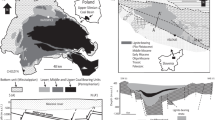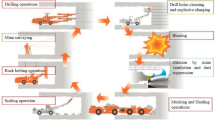Abstract
All major opencast mining activities produce dust. The major operations that produce dust are drilling, blasting, loading, unloading, and transporting. Dust not only deteriorates the environmental air quality in and around the mining site but also creates serious health hazards. Therefore, assessment of dust levels that arise from various opencast mining operations is required to prevent and minimize the health risks. To achieve this objective, an opencast coal mining area was selected to generate site-specific emission data and collect respirable dust measurement samples. The study covered various mining activities in different locations including overburden loading, stock yard, coal loading, drilling, and coal handling plant. The dust levels were examined to assess miners’ exposure to respirable dust in each of the opencast mining areas from 1994 to 2005. The data obtained from the dust measurement studies were evaluated by using analysis of variance (ANOVA) and the Tukey–Kramer procedure. The analyses were performed by using Minitab® 14 statistical software. It was concluded that, drilling operations produce higher dust concentration levels and thus, drill operators may have higher incidence of respiratory disorders related to exposure to dust in their work environment.
Similar content being viewed by others
References
Chaulya, S. K., Ahmad, M., Sıngh, R. S., Bandopadhyay, L. K., Bondyopadhay, C., & Mondal, G. C. (2003). Validation of two air quality models for Indian mining conditions. Environmental Monitoring and Assessment, 82, 23–43.
Donoghue, A. M. (2004). Occupational health hazards in mining: An overview. Occupational Medicine, 54, 283–289.
Ghose, M. K. (2007). Generation and quantification of hazardous dusts from coal mining in the Indian context. Environmental Monitoring and Assessment, 130, 35–45.
Ghose, M. K., & Majee, S. R. (2000). Sources of air pollution due to the coal mining and their impacts in Jharia coalfield. Environment International, 26, 81–85.
Ghose, M. K., & Majee, S. R. (2007). Characteristics of hazardous airborne dust around an Indian surface coal mining area. Environmental Monitoring and Assessment, 130, 17–25.
Johnson, R. A., & Bhattacharyya, G. K. (1992). Statistics principles and methods. New York: Wiley.
Jones, T., Blackmore, P., Leach, M., Bérubé, K., Sexton, K., & Rıchards, R. (2002). Characterization of airborne particles collected within and proximal to an opencast coalmine: South Wales, U.K.. Environmental Monitoring and Assessment, 75, 293–312.
Lowry, R. (2000). Two-way analysis of variance for independent samples. Factorial ANOVA: Independent samples. http://faculty.vassar.edu/lowry/PDF/c16p1.pdf. Retrieved April 27, 2006, from Vassar College.
Menasce, D. A. (2001). Design of experiments: One factor and randomized block experiments http://www.cs.gmu.edu/~menasce/cs700/files/OneFactorExpDesign.pdf. Retrieved April 07, 2006, from Dept. of Computer Science, George Mason University.
Minitab (2005). Analysis of variance. Minitab 14 help-to-go files. http://www.minitab.com/support/docs/rel14/14helpfiles/Statistics/AnalysisofVariance.pdf. Retrieved November 19, 2007.
Mukherjee, A. K., Bhattacharya, S. K., & Saiyed, H. N. (2005). Assessment of respirable dust and its free silica contents in different Indian coalmines. Industrial Health, 43, 277–284.
Naidoo, R., Seixas, N., & Robins, T. (2006). Estimation of respirable dust exposure among coal miners in South Africa. Journal of Occupational and Environmental Hygiene, 3, 293–300.
Redd, A., Rister, K., & Young, E. (2005). TAMU ANOVA. ANOVA Extensions to the GNU scientific library version 0.2. http://www.stat.tamu.edu/~aredd/tamuanova/tamu_anova.pdf. Retrieved April 13, 2006, from Texas A&M University.
Sanders, D. H. (1990). Statistics a fresh approach. New York: McGraw-Hill.
Sengupta, M. (1990). Mine environmental engineering. Florida: CRC.
Seward, S. (2004). Analysis of Variance, Statistics course on PowerPoint slides (chapter 10). In Statistics for managers using Microsoft® Excel, 4th ed. www.sonoma.edu/users/s/seward/211file/chap10.ppt. Retrieved February 14, 2006, from Sonoma State University.
Stoodley, K. D. C., Lewis, T., & Stainton, C. L. S. (1980). Applied statistical techniques. England: Ellis Horwood.
Author information
Authors and Affiliations
Corresponding author
Rights and permissions
About this article
Cite this article
Onder, M., Yigit, E. Assessment of respirable dust exposures in an opencast coal mine. Environ Monit Assess 152, 393–401 (2009). https://doi.org/10.1007/s10661-008-0324-4
Received:
Accepted:
Published:
Issue Date:
DOI: https://doi.org/10.1007/s10661-008-0324-4




